Finally Reconnecting in Person at VOICES London 2022
After two years of transformation, internal communicators gathered to assess their newfound stature and its accompanying challenges. And also to have some fun!
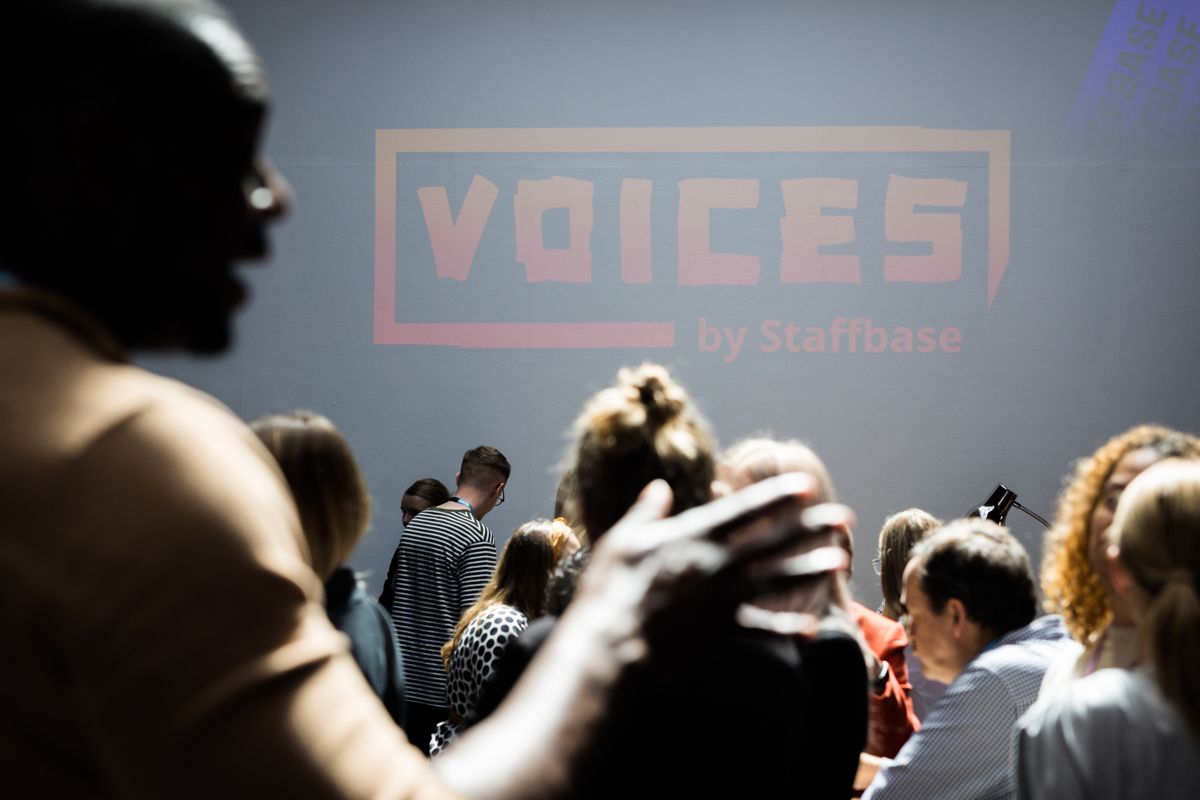
Have you ever had one of those days when you step out of your normal routine and in the process realize just how much awesomeness can happen in 24 hours? That was my experience at VOICES London 2022. The world’s top conference for internal communications professionals hadn’t taken place in person since 2019. And back then it only happened in German, so viel Glück with that, anglophones.
Not only was the gathering at Tobacco Dock on May 19 the first time in two years that I’ve ventured away from my home office cocoon and out into the wider world of work, but it was also the first time since the pandemic that I’d been on an airplane, stayed in a hotel, or ridden the subway. (Sorry, I mean the Underground. I’m a New Yorker at heart.)
And from from all of the happy faces I saw, I could tell that I wasn’t the only one thrilled to be braving entrance into our (almost? please?) post-Covid world. Being back among friends and colleagues was a thrill for everyone in attendance. There was a joy in the air that I don’t remember ever seeing at a professional event — aside from when the bar opens.
I’m really glad I was there, and I hope you were, too! And if you weren’t, then don’t make that mistake again!

Welcome to VOICES London 2022
VOICES London 2022 opened with a warm welcoming address from Adam Brayford, the Staffbase Director of Internal Communications, whose engaging online persona was unsurprisingly even more animated IRL. His enthusiasm made him the perfect host for the day, personifying the example of how nothing beats interaction with a living, breathing, human being. On this note, Adam greeted the crowd of around 150 attendees by happily acknowledging that, “We’re back, realizing all the magic that can happen when meeting in person.”
Adam wasted no time in introducing Jenni Field, the founder of Redefining Communications. The award-winning podcaster, global communication strategist, and author of Influential Internal Communication was on hand to talk about the State of the Industry and Internal Communication Trends.
The State of the Industry and Internal Communication Trends
Jenni began by recognizing that “organizations are people and people haven’t really changed that much. But the world around us has changed significantly.” She was speaking primarily about the emergence of hybrid work, but she urged companies to stop looking at it strictly as a location-based scenario. This limited viewpoint, she warned, risks missing the opportunity to really redesign work. Above all else, she said, “Work has to be a great experience.”
Jenni Field says, “Put people first!”
Jenni then identified five core internal communication trends. It probably didn’t come as a surprise to the seasoned comms pros in attendance when she acknowledged that these trends were nothing new, but that they’d been mostly ignored until now.
 Jenni Field announces the revolution in internal comms.
Jenni Field announces the revolution in internal comms.
“Engaging teams around purpose, strategy, and values,” she said, “has to go deeper than just saying we’re doing it.” Again she highlighted the need to place employee experience above all else. And she stressed that organizations need to be very clear about their specific purpose, strategy, and values.
When it comes to adapting a channel strategy for hybrid working, the foundation must consist of a content framework, a channel matrix, and a stakeholder map. And companies must do a better job of enhancing people manager communication skills and tools. “Now is the opportunity for us to invest in line managers, giving them control over the budget, resources, and people in their team.”
“Change can’t happen without trust.”
Jenni also pointed out that trust in leadership and in each other depends on mutual respect, fairness, and integrity. “How trusted are your leaders?” she asked. “There has to be trust in your whole leadership team. Change can’t happen without trust.”
Finally, Jenni stated that there are distinct definitions for employee engagement, employee experience, and internal communication. And they need specific definition, as they obviously vary from organization to organization.
She closed with these words of comms wisdom: “Our job as internal communicators is about employee alignment. Don’t ever be too busy to take action and drive growth in internal communication. The revolution brought on by the pandemic is a great opportunity to re-imagine work. And doing so means putting people first. Go forth and embrace the opportunity.”
Communicators Move People
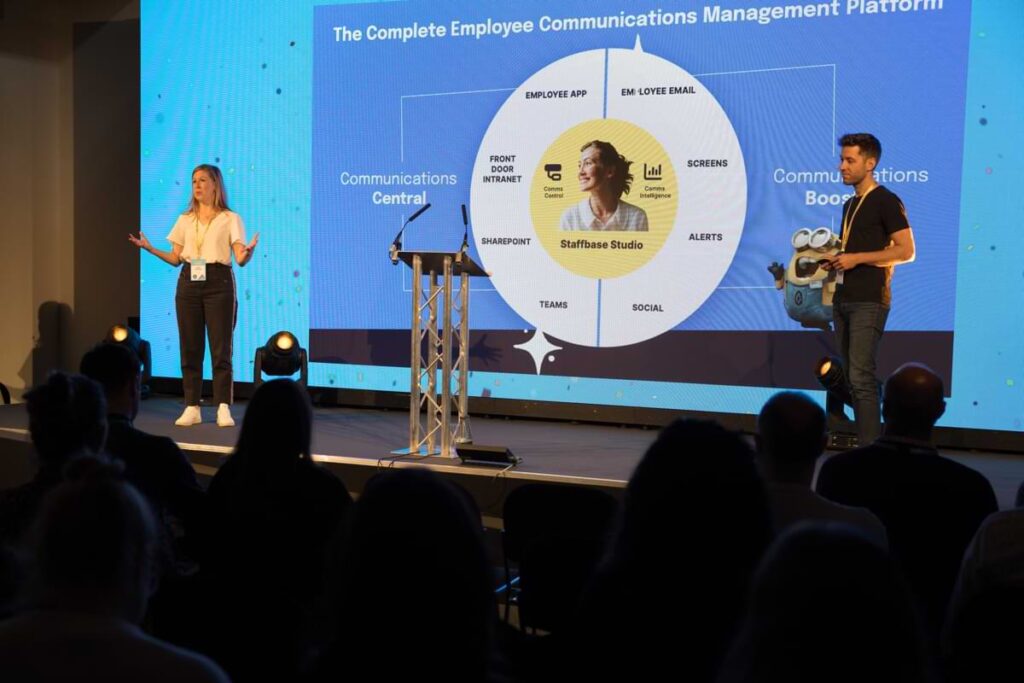 Staffbase Head of Product Marketing Lara Dobson and CEO Martin Böhringer.
Staffbase Head of Product Marketing Lara Dobson and CEO Martin Böhringer.
Staffbase CEO Martin Böhringer and Head of Product Marketing Lara Dobson were next on stage to discuss how the IC community has grown over the past few years — and how Staffbase is keeping pace with these changes by addressing their emerging needs.
Martin began by pointing out that it’s no longer enough for communicators to control the channel. Now it’s equally important to control the narrative. “We can’t hide behind our internal channels anymore,” he said. “The narrative doesn’t stop there. And getting everyone to agree upon a shared narrative is key to leading transformation.”
The massive need to guide organizations through transformation requires a shared view of the challenges. Fortunately, trust in corporate comms is at an all-time high. The Edelman Trust Barometer reports that 77% of those polled identified their employer as being their most trusted source of information.
That being said, the challenges of transformation are too big to be driven solely from the top. Companies need all hands on deck to make it happen. This means there needs to be a new form of leadership that places value in the role of the workforce to lead companies forward.
Workforces are suddenly the 3rd highest priority of CEOs
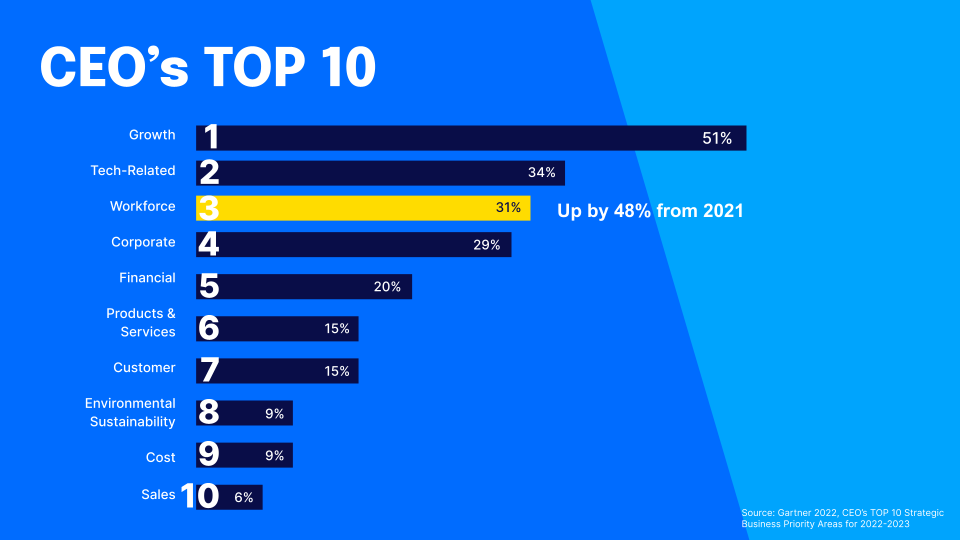 CEOs today report their workforces to be their third highest priority, up 48% since 2021.
CEOs today report their workforces to be their third highest priority, up 48% since 2021.
Luckily, CEOs today report their workforces to be their third highest priority, up 48% since 2021. This has resulted in a 54% increase in IC budgets in the same span of time. Today, nearly all companies see comms as owners of the corporate narrative.
Given these developments, today’s communicators must partner with senior leadership, align on the strategic priorities, and ultimately shift people’s hearts and minds in a new direction. This is how communication will create impact, which is best manifest in employee behavior and real business success.
If it sounds complicated, that’s because it is. Market researcher Forrester has pointed out that “communications professionals must navigate an increasingly complex digital channel landscape and messaging minefield.” And despite their newfound seat at the table in the wake of the Covid-19 pandemic, communicators still report spending 75% of their time reacting to requests to “get stuff out.”
New tools for old challenges
It’s these sorts of crucial challenges that motivated the big product announcements of VOICES London 2022. They were led by Staffbase Communications Control, a tool for orchestrating strategic planning across all organizational teams and channels.
Lara revealed the omnichannel insights of another new Staffbase feature, Communications Intelligence, which “allows internal communicators to see which channel has the highest engagement.”
And there was also the big reveal of a new aspect of the Staffbase Studio, the Editorial Calendar: “one easy-to-use communications CMS to rule them all.”
Rounding out these new features of the Staffbase Internal Communications Management Platform is Staffbase for Sharepoint and Teams, designed to turn Microsoft touch points into top-notch employee comms experiences. “We want communicators to go from broadcasting to impacting, with lightweight comms channels that reach everyone with Staffbase for Sharepoint and Teams,” said Martin.
And that wasn’t all. Staffbase also introduced a suite of Communications Boosters to speed up your internal comms. These boosters include employee email, screens, social media channels, and SMS alerts – all designed to reach employees when it matters most.
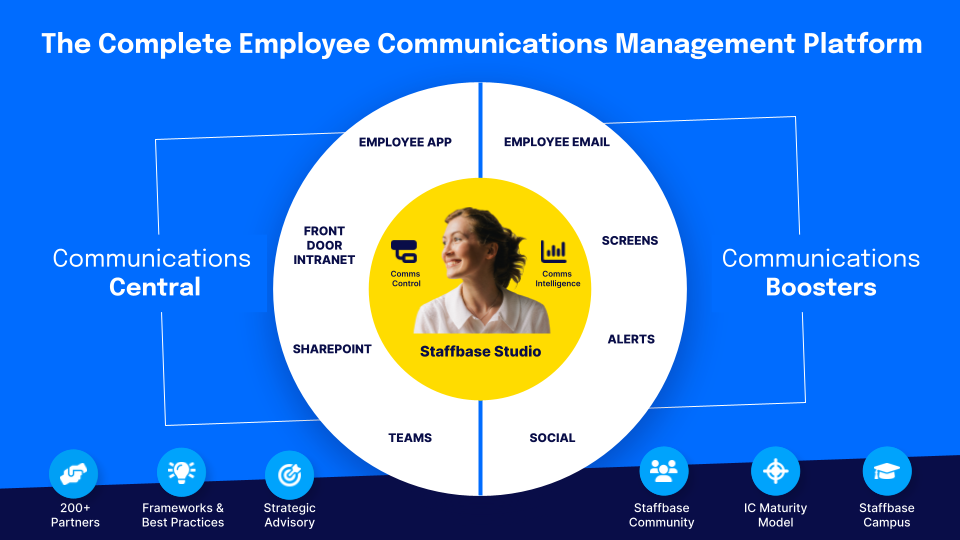
Introducing Staffbase Campus
Finally, in an effort to support the growing internal comms community, Staffbase announced the launch of Staffbase Campus, a series of powerful e-learning courses to help communicators get certified in today’s top comms topics.
This was a lot of exciting information to digest, and yet VOICES London 2022 was just getting started.
Authenticity: Why Communication Must be More Than Just Performative
 Mark Webb, Chaya Mistry, and Max Puller.
Mark Webb, Chaya Mistry, and Max Puller.
The next presentation of VOICES London 2022 featured Chaya Mistry, Director and founder of Humanly; Max Puller, Director at BCW Global; and Mark Webb, Head of Internal Communications at Shift.ms. The trio were on hand to discuss the positive (and negative) impact that including the full spectrum of employee voices can have on internal comms.
Mark Webb led the panel with the observation that “authenticity is the new battleground; if you want to keep and engage your staff you need to be authentic.” Mark offered some of the most personal and memorable insights of the day by being open, honest, and even funny as he spoke about about his diagnosis with multiple sclerosis. At one of his previous workplaces, news of his illness was met with such a supportive response that he’s still a staunch advocate of the company. His story was a case in point for the power of authentic, honest, and heartfelt communication.
On this note, Max Puller pointed out that leaders and managers must truly mean what they say. Credibility, he noted, is key to managing change. “It’s moments of authenticity that create trust,” he said.
Chaya Mistry reminded the audience that challenging moments require real connection and the need to “be yourself.” That can’t happen, of course, if companies don’t let their people be their true selves.
“You can’t have trust without truth.”
As for moments of change or crisis, it’s the bad times that people tend to remember. That’s one reason why authentic leadership is critical in such moments. Organizations need to show their emotions and to be authentic during times of vulnerability. It’s those moments when people really want to connect that they need to be their most authentic.
The panel at VOICES London 2022 agreed that it was the job of internal communicators to move leaders along the path to authenticity. The more feedback leaders have about how authentic they come across, the better they will understand where they need improvement. The first step is getting them to realize how employees perceive them. In this regard, data and factual insights will promote confidence in leadership to drive authenticity forward.
Chaya made an interesting point when she said that she sometimes feels sorry for leaders. “They never had to learn to be authentic. That’s why we as communicators have to help them feel comfortable with being themselves. Leaders have to unlearn what they’ve already learned.”
But ultimately, she said, “You need to know yourself to fully be yourself. You can’t have trust without truth.”
Employee Engagement in Times of Change
 Lindsay Hill, Kirstie Henry, Jessica Cooney, Carra Smith, and moderator Melanie Lanick.
Lindsay Hill, Kirstie Henry, Jessica Cooney, Carra Smith, and moderator Melanie Lanick.
How do you stay in front of evolving employee needs? How do you create space for employees to share their concerns? Carra Smith and Kirstie Henry, internal communication managers from the Hampshire and Isle of Wight Integrated Care System, along with Jessica Cooney and Lindsay Hill from the Sovini Group, were on hand at VOICES London 2022 to share how they manage the ever-changing comms landscape.
“‘What do we do?’ was the first question we had when the pandemic began,” said Kirstie Henry. “The challenge was to engage with people and to make them feel that they were still part of the organization.”
Jessica Cooney recalled that people were really struggling with their mental health. “The importance of mental health at the workplace grew significantly during the pandemic. But the positive outcome was that employees now feel encouraged and supported so much that they’re more comfortable telling their personal stories.”
But these stories aren’t always positive. In times of change, it’s important not to hide critical comments. Communicators need to listen to the people sending negative messages, address their concerns, and start an open conversation about what went wrong. That kind of authenticity will only drive engagement.
Nevertheless, Lindsay Hill acknowledged that “you can’t get everyone deeply engaged. Some of your employees just want to do their job and get paid, and that’s also okay.” But as Jessica Cooney noted, “As long as people know that the culture is open to them and that they can engage in their own way, then it’s fine.”
The pandemic was hard on employees. But one positive outcome was that while the role of internal comms was previously totally underestimated, “Now,” says Lindsay, “we know it can change people’s lives.”
View from the C-Suite: the Growing Importance of Being a Communicative Leader
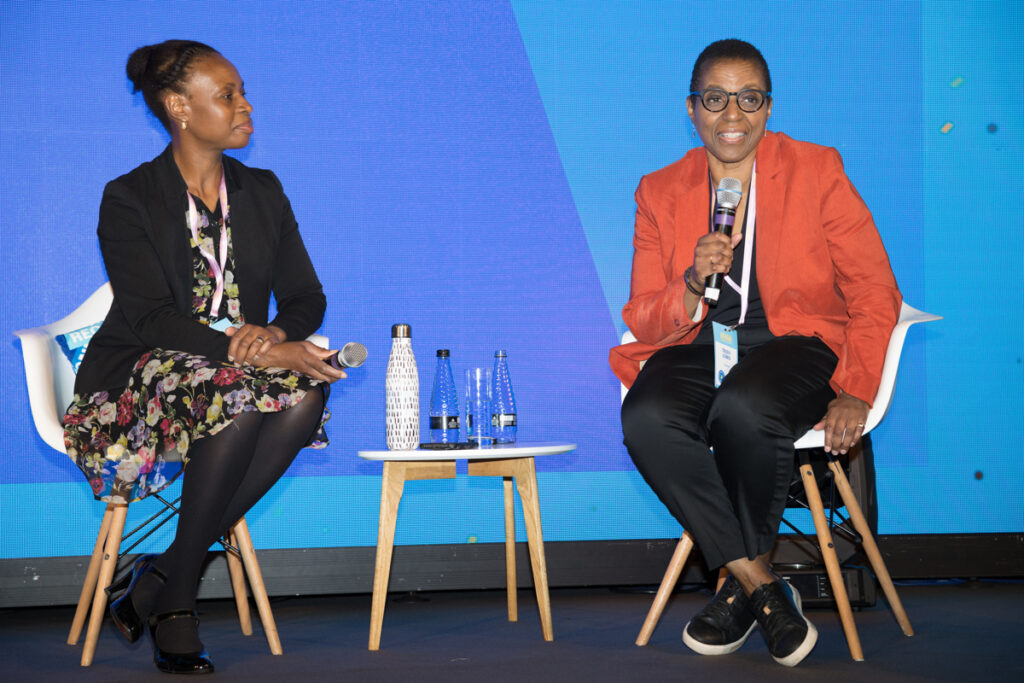 Kate Isichei and Trudy Lewis.
Kate Isichei and Trudy Lewis.
It’s no secret that today’s workforce wants to be more connected. And this means connecting with leadership too. Trudy Lewis, the Director of Colinear and Kate Isichei, the Director of Where to Look Comms, were at VOICES London 2022 to share how leaders can better engage with their teams by creating an open environment of communication.
What’s the difference between leaders and managers when everyone’s a potential leader? Good leadership comes from being genuine, being yourself, and having the ability to connect with people. If you have something to say and can make people follow you, then you can lead.
The point is that good leaders have to be good communicators. Trudy Lewis made it clear that if you’re in a leadership role but you don’t have the appreciation or the ability to communicate, then you can’t be your best as a leader.
Putting leaders in a position to communicate is key. According to Kate Isichei, “It’s important to match personalities with the right channel. Data can really help in this regard, allowing you to understand people and providing a basis for decision making.”
As a communicator, “You need to question and you need to build rapport with the C-Suite,” said Trudi. “If leaders know that they can trust you with information, then they’re more likely to work with you.” Kate followed this thought by saying that “you have to be everybody’s friend: kind of a spy, a facilitator, a connector of the dots, and in some ways also acting politically as a mediator between comms and leadership. Personal assistants and executive assistants should be your best friends as key stakeholders.”
As for the subject of employee engagement, Kate reported that she starts by looking at the approval rates of customers. Strong customer engagement, she believes, is always related to a positive employee experience. As to who owns employee engagement inside organizations, Trudy says it’s everyone’s business.
People inside organizations need to understand what internal comms is, as well as what they do and the importance they have. “To get top talent to stay, communicators need to make sure these people understand the organization’s vision and the important part they play in making it a reality. To engage people in what they do, work must be meaningful. That can only happen if you stand behind the values and the statements that you communicate.” This, said Trudy, is “maybe the most crucial question for employee engagement.” Authentic communication must be aligned with the culture if you want to get your employees truly engaged.
Wrapping up the conversation, Kate raised a topic well known to communicators. “We’re always asking for a seat at the table,” she said. “But what’s the point if once you have it you still let people tell you what to do or push you around?”
Trudy agreed. “We have to be determined to push and not give up. We need to have and hold that seat and we must prove our relevance. And we need to stop worrying about the position and instead just grab it. Put yourself in the frame, show your relevance, and shape the future.”
A Seat at the Table: the Transformation of Internal Communicators
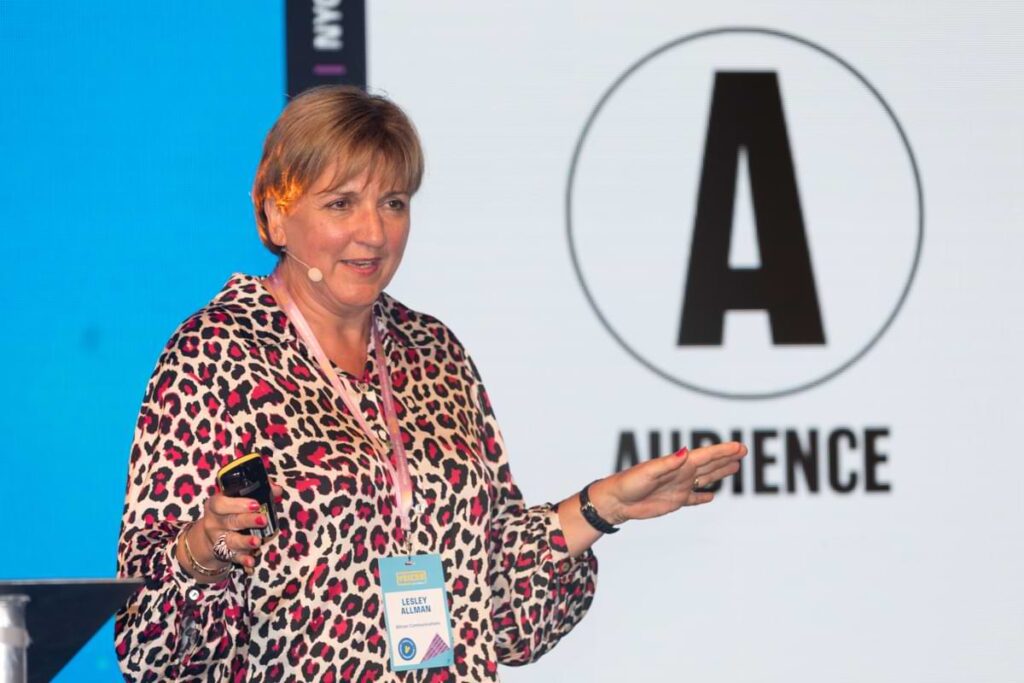 Lesley Allman
Lesley Allman
Lesley Allman of Allman Communications had the unenviable task at VOICES London 2022 of giving the morning’s final presentation before lunch. But she had important lessons to share about a seismic shift in the role of internal communicators: the evolution from mere delivery person to trusted advisor.
“In the past,” she said, “internal communications was considered the post office of the organization.” Today, comms help to drive employee engagement, working strategically and focusing on topics that add value.
These days, she said, “Simply telling people is not enough. It takes a lot of time and involvement to really engage employees and to change behavior.”
In an effort to be more strategic, Lesley created her ABCDE Model:
Audience
You need to understand your audience. Who are you trying to reach and who are your potential blockers and enablers?
Behavior
Behavior is the why. Why are we communicating? What do we want people to do, say, think, and feel? How can you motivate them to make the required change?
Content
What are the key messages of the content you’re publishing? Will it connect? Is it clear, compelling, in context, and concise? And what’s your role in the content creation process?
Delivery
Be clear about which channels you choose for your messages and consider whether line managers and leaders need communication capability.
Evaluation
Think about what success looks like and see whether your communication has created the desired impact.
Lesley stressed that communicators need to prioritize their activities and learn to say no to requests that aren’t worth the effort. “Doing so will allow you to spend your time more effectively in the future.”
She closed by revealing the harsh reality that “business leaders aren’t interested in internal comms – they’re only interested in what it can deliver. That’s why you need to focus your time, effort, and budget on delivering the behavior change necessary to get a seat at the table.”
To be taken seriously you need business acumen, accountability, courage, and curiosity. And don’t forget that you need to be more strategic to get your seat at the table.”
Lesley Allman, author of Better Internal Communication: How to Add Value, Be More Strategic, and Fast-Track Your Career
 Let’s not forget about lunch!
Let’s not forget about lunch!
Transformation Through Storytelling
 Ralf Junge-Pearl, Gihan A.M Hyde, Lindsay Kohler, and Elle Bradley-Cox.
Ralf Junge-Pearl, Gihan A.M Hyde, Lindsay Kohler, and Elle Bradley-Cox.
Is there anything a good story can’t do?
Elle Bradley-Cox, Senior Editorial Consultant at scarlettabbott; Gihan A.M Hyde, CEO and founder of CommUnique; and Lindsay Kohler, Lead Behavioral Scientist at scarlettabbott, started the afternoon sessions of VOICES London 2022 by discussing how communicators can lead transformation with compelling storytelling.
Staffbase Head of Content Ralf Junge-Pearl led the panel by acknowledging that storytelling is a basic human need, helping people to create culture and manage change. Elle Bradley-Cox heartily agreed, saying, “Life without stories isn’t worth living.”
The panel discussed the elements that make a good story, and pointed out that most good stories need an antagonist to motivate the actions of the hero. Harkening back to the morning session with Staffbase CEO Martin Böhringer, the speakers brought up the fact that with so much focus on leaders at all times, they don’t always have control of the corporate narrative.
Despite such obstacles, storytelling can play an important role within organizations, even helping to uncover issues that might otherwise remain hidden. The key is to think about the response you want your stories to have. According to Elle, “If you want to tell an effective story, focus on making it transparent, honest, and constructive.” Good stories need to explain the why, not the when. Start with the hook, make your stories honest, and appeal to the values and emotions of your readers.
All three panelists agreed that there’s no such thing as a story that shouldn’t be told. Lindsay Kohler said, “There’s a place for every story, as long as it’s well told.” And don’t be afraid of stories that aren’t completely positive. Some stories will benefit by including emotions like sadness or anger. It depends on the outcome or action you’re after. In this light, Elle said storytellers shouldn’t be overwhelmed by the technicalities of the story they’re telling. “Humanize it, and focus on the outcomes,” she advised.
Gihan A.M Hyde made the important point that asking authentic questions can spur transformation. She went on to reveal why she believes that skeptics can often be the best critics of your storytelling. “If you can gain the trust of your skeptics,” she said, “then you know you’ve gotten your message right.” She also told the audience, “Listen to how children tell their stories and learn from their enthusiasm and attention to detail.”
Release your inner journalist.”
Elle Bradley-Cox, Senior Editorial Consultant, scarlettabbott
Again the subject of communicators gaining positions of influence came up. And the panel agreed, “Communicators need to do a better job of demanding a seat at the table as opposed to waiting for one to be given to them.”
A good story might be just the ticket.
Crafting Content: Tales from the Industry
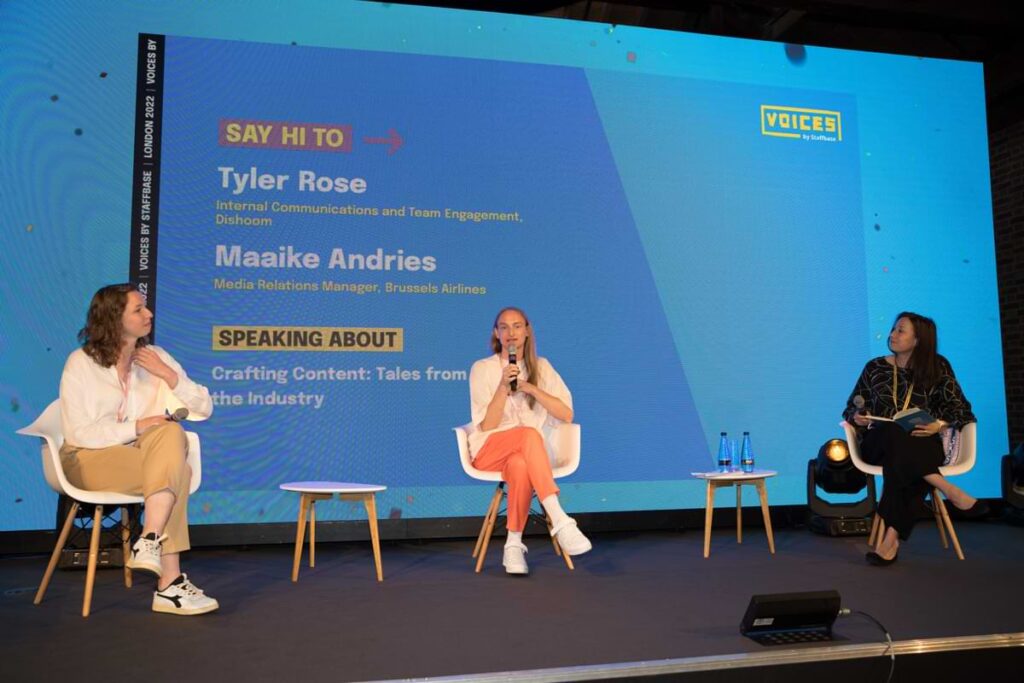 Maaike Andries, Tyler Rose, and Matilda Kivinen.
Maaike Andries, Tyler Rose, and Matilda Kivinen.
The afternoon then moved from storytelling to crafting content, with comms experts Tyler Rose, who focuses on internal communications and team engagement at Dishoom; and Maaike Andries, Media Relations Manager at Brussels Airlines. The pair were at VOICES London 2022 to discuss effective tools and techniques for communicators looking to craft content that elevates their messaging across multiple channels.
“The key is targeted communication,” began Maaike. “For example, stories that happen onboard are especially appealing to our flight attendants.” The key is to craft stories with your target audience in mind. Nevertheless, having so many target groups makes crafting content a challenge.
Surveys can help in this regard, because they will reveal the content your readership craves. Anonymous feedback is best, because it’s the most honest. But no matter your content, authenticity is invaluable.
“Most of the time,” cautioned Maaike, “people don’t care about your story. In fact, they barely read it. They need to see what’s in it for them. The time of your employees is valuable, so make sure your messages are crisp and contain a call to action.”
For her, data is key, allowing communicators to craft targeted, relevant content. But there are certain surefire methods. One certainty is that video content will always outperform a long email. But whatever content you’re crafting, it’s best when it’s bold, fast, and easy to read.
Tyler advised communicators to be creative, and to make things colorful and enjoyable. He also pointed out how important a sense of community is to today’s workforce. “Readers want to feel connected to the storytellers,” he said.
To be really authentic, communicators should be free to tell their own stories. “It’s more likely that people will believe your stories if you choose the right spokesperson.” Tyler advised content creators to be as authentic as possible when creating content, and to be alert to the different tones and expectations of your internal audience.
Maaike told a great story about how Brussels Airline created a video feature for their employee app about what was happening with the airline’s fleet while it was grounded during the Covid-19 lockdown. It was such a unique piece of content that it eventually made its way to CNN.
Tyler got the biggest laugh of the day when he acknowledged that he couldn’t top Maaike’s CNN story. But his key takeaway was that well-crafted content should “try to make everyone happy and feel comfortable at work.”
Been There Done That: Recipes for Successful Comms Channel Adoption
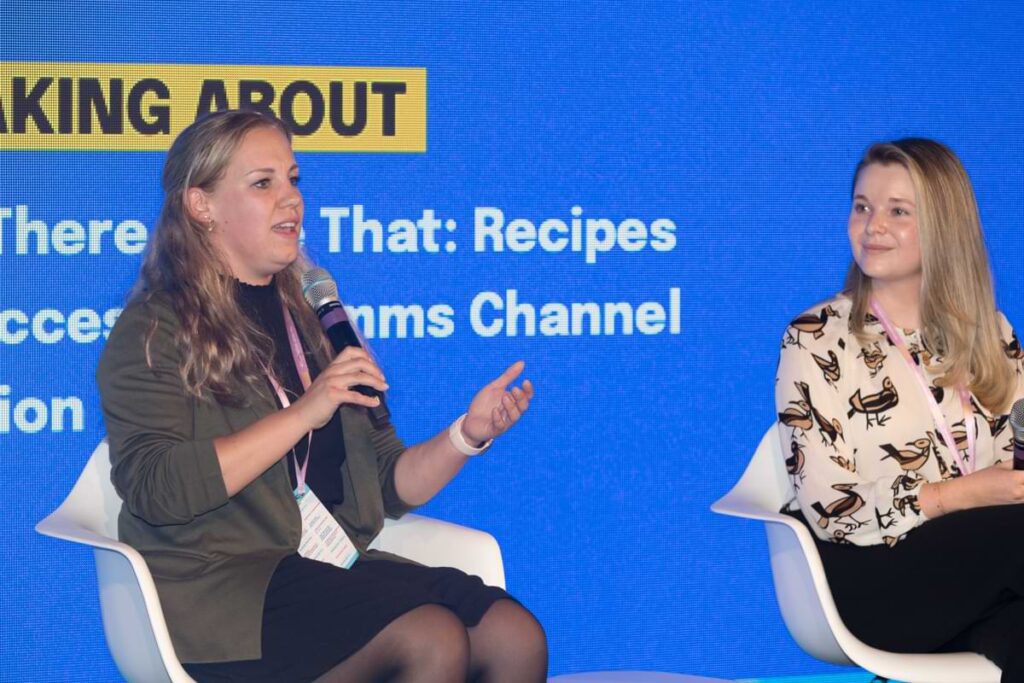 Kim Huntjens and Johanna Lindberg.
Kim Huntjens and Johanna Lindberg.
Staffbase has built the world’s greatest employee communications management platform. On that we can agree. But we’re only half of the equation when it comes to how successful digital comms tools can be in any organization. The rest is up to you. That’s why the subject of channel adoption is so vital.
Johanna Lindberg, a corporate communications officer at the BIL Group; and Kim Huntjens, Operational Communications Specialist at VodafoneZiggo, were next on stage at VOICES London 2022 to talk about the strategies used in their companies for getting employees to adopt their respective apps.
Before you even begin, the two agreed, it’s important to identify any and all possible blockers. This is the best way to prepare for overcoming them. Both companies ran pre-launch campaigns designed to build interest in the new platforms. And both agreed that having unique content in the app immediately available upon registration was key to strong adoption.
One unexpected outcome was actually quite welcome. Employees turned out to be the main drivers of content creation. This may have been a byproduct of providing target groups in both companies with an experience that matched their expectations and met their interests.
Field technicians were the first to use VodafoneZiggo’s app. But it was so successful that employees now want to use it for all their communications. The danger, of course, is that without continued relevance and structure, it won’t work. It takes patience to tailor your comms to a broad swath of employees. That’s because all enterprise companies have a large and varied audience that needs to be targeted appropriately with relevant content.
For BIL Group, the upshot of having a single comms channel meant that changes in the company’s communications culture were necessary. For instance, critical comments, although rare, now often lead to face-to-face discussions.
But given the professional nature of the platform, it doesn’t generate the kind of negativity sadly seen on other social media platforms. It’s not anonymous, in other words, and that generally leads to greater self-moderation.
That makes the comms channel a safe space. As such, even more users are likely to adopt it as the one place to listen and make themselves heard.
The Power of Comms Compels You: The Role of Reconnection in Creating a Movement
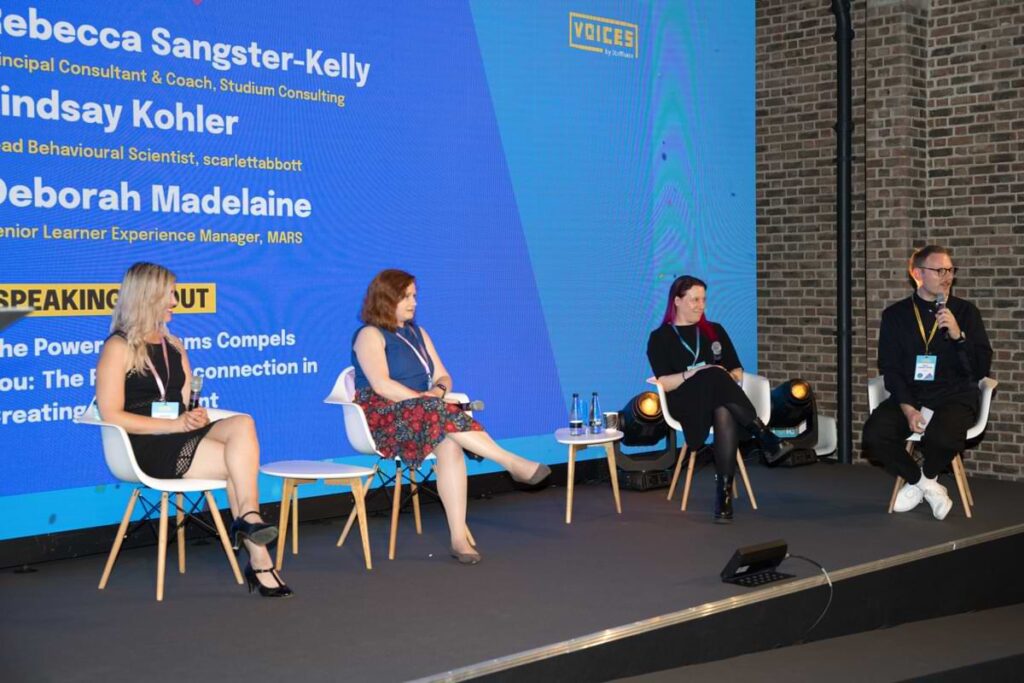 Lindsay Kohler, Rebecca Sangster-Kelly, Deborah Madelaine, and Ralf Junge-Pearl.
Lindsay Kohler, Rebecca Sangster-Kelly, Deborah Madelaine, and Ralf Junge-Pearl.
The final presentation of VOICES London 2022 was about the ways IC can play a critical role in navigating the change and transformation happening in so many contemporary companies.
By movement, the panel of Lindsay Kohler, Lead Behavioral Scientist at scarlettabbott (in her second appearance of the day); Deborah Madelaine, Senior Learner Experience Manager at MARS; and Rebecca Sangster-Kelly, Principal Consultant and Coach at Studium Consulting, was referring to a management technique designed to engage people around the idea of change.
Moving employees toward an action takes time. Luckily, there’s a tipping point beyond which acceptance to change begins to snowball.
Communication can motivate a person to follow through with the promise of a reward or its opposite in the form of some feared outcome. This motivation is so important. By allowing employees to co-create the direction of change, communicators can tap into the emotional triggers that will appeal to anyone excited by the idea of making an impact.
It’s important to remember that as rational as people believe themselves to be, they are far more motivated by emotions. That’s why it’s important for communicators to understand the emotions of their audience in order to motivate them effectively.
Internal communication needs to be part of creating a movement from the very beginning. But movements are also finite. They must evaluated as to whether your desired actions have or haven’t been taken. Effective comms can help you to diagnose problems and build engagement. But remember, purpose without a plan is pointless.
Now, on to the prizes! VOICES Awards 2022
 The VOICES Awards 2022.
The VOICES Awards 2022.
The VOICES Award was first presented in 2021 as part of the virtual VOICES conference for companies from the Staffbase community. At VOICES London 2022, Staffbase also honored successful communication projects with the award and recognizing the commitment to internal communication of its growing community.
The Award for Highest Active Reach
The VOICES Award for Highest Active Reach went to Millennium Support. The company has cracked the code for maximizing the reach of news to its employees: a smart use of push notifications, weekly leadership updates, creating and communicating to employee communities, and news with options for 2-way communication are just some of the best practices the company applies on a daily basis.
The Award for Highest Engagement Rate
SMC France got the VOICES Award for Highest Engagement Rate. They’ve found the perfect mix between company- and employee-driven news, driving likes, comments, and shares on a daily basis.
The Award for Best Newsletter Design
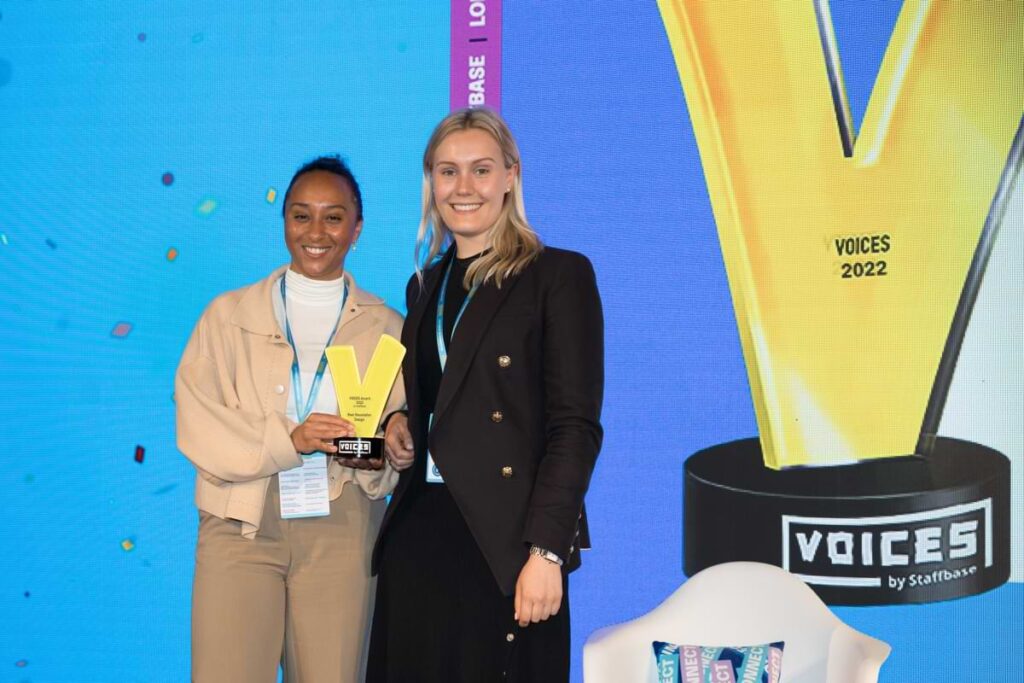 The VOICES Award for Best Newsletter Design was won by Farfetch.
The VOICES Award for Best Newsletter Design was won by Farfetch.
Farfetch received the VOICES Award for Best Newsletter Design. They clearly showed how good design is essential to good communication; they’ve nailed creating a newsletter that’s read by more than 8,000 users on bi-weekly cadence, greatly improving access to important company information. But not only are these emails filled with engaging news — they’re also beautifully designed!









